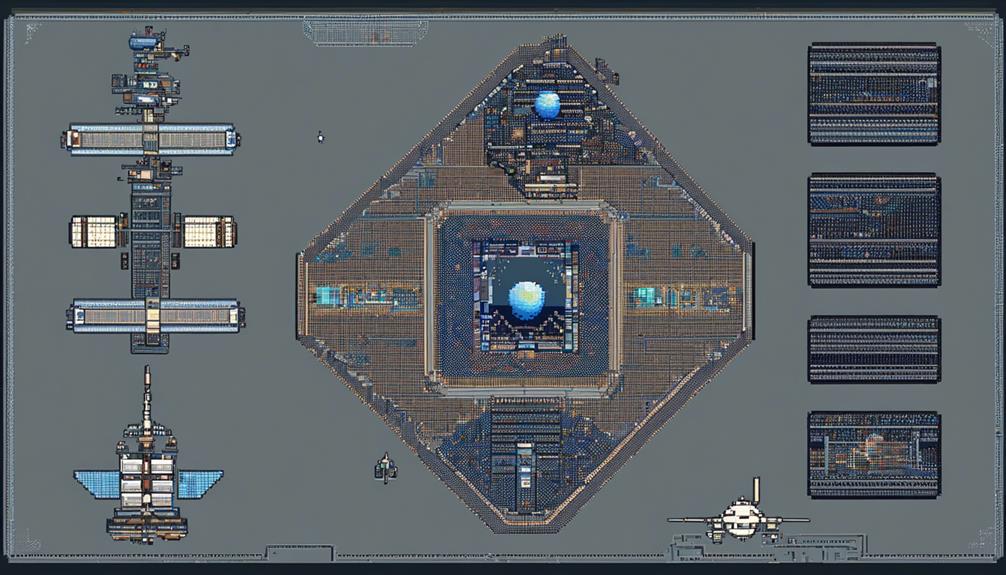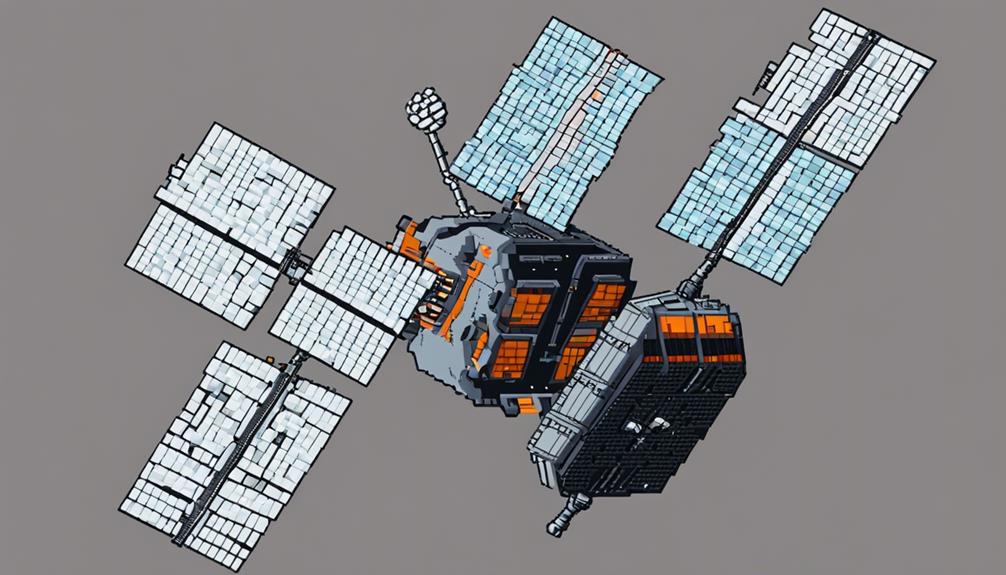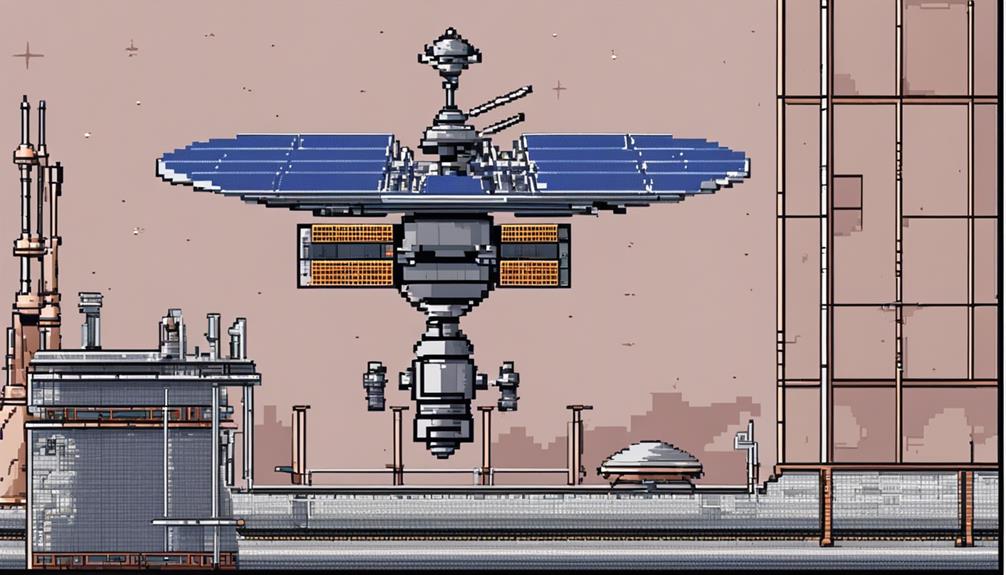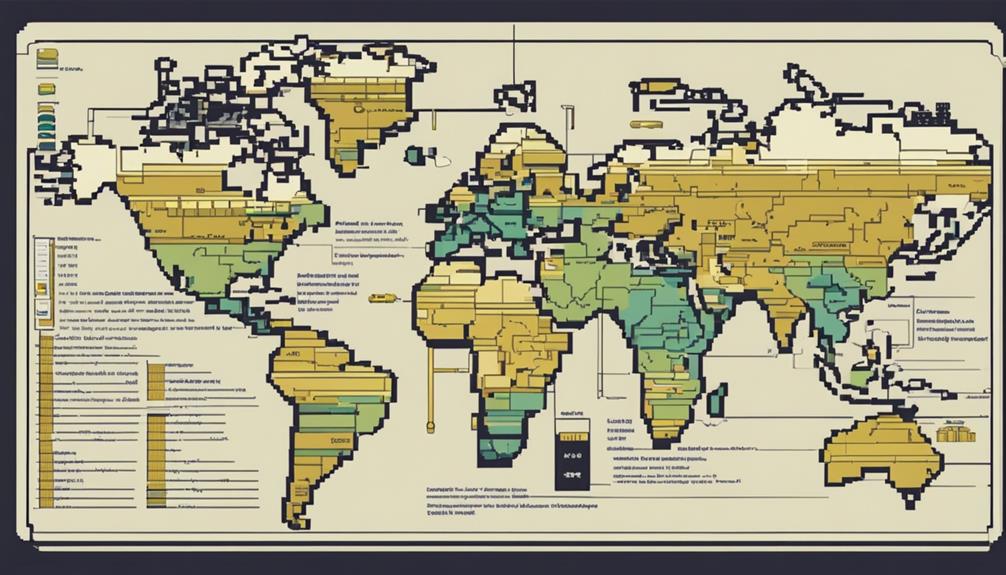The intricate realm of radiation shielding in satellites stands as a cornerstone in fortifying spacecraft against the relentless onslaught of space radiation. Through a meticulous fusion of high-density and low-density materials, shield designers fashion a robust defense mechanism that safeguards vital electronics from the detrimental effects of radiation exposure. Leveraging sophisticated computational tools like Monte Carlo simulations and genetic algorithms, engineers meticulously craft shielding structures that not only deflect primary radiation but also curtail the generation of secondary particles. As we unravel the complexities of satellite radiation protection, the quest for innovative shielding solutions and the anticipation of future trends beckon us to explore the ever-evolving landscape of spacefaring technology.
Key Takeaways
- Multilayer shields with materials like polyethylene and Kevlar optimize radiation protection in satellites.
- Shield optimization involves balancing efficacy, weight, and cost considerations for efficient solutions.
- Advanced composite materials reduce weight while enhancing radiation shielding in satellites.
- Collaboration drives the development of novel shielding materials and technologies for satellite applications.
Multilayer Shielding Systems for Satellites

In the realm of satellite design and space exploration, the utilization of multilayer shielding systems stands as a critical methodology for enhancing radiation protection and ensuring the integrity of electronic components in the harsh space environment. Multilayer shielding systems for satellites involve a strategic combination of high-density materials such as tantalum and low-density materials like polyethylene to achieve optimal protection against radiation exposure. Computational methods, particularly Monte Carlo simulations, play a pivotal role in the design and optimization of these multilayer shields to ensure their efficiency in safeguarding satellite subsystems.
Experimental validation has underscored the efficacy of multilayer shields in reducing radiation exposure for electronic components operating in space environments. Comparison studies have further highlighted the superiority of multilayer shields over traditional shields like aluminum when it comes to protecting sensitive satellite subsystems from the detrimental effects of radiation. To achieve the ultimate optimal shield configuration for satellites, a judicious mix of materials including Bronze, Aluminum, and Molybdenum is often employed to maximize the shielding effectiveness against varying levels of radiation encountered in space.
In essence, the deployment of multilayer shielding systems represents a sophisticated approach to mitigating the risks posed by radiation exposure to satellite electronics, ensuring the longevity and functionality of critical satellite subsystems in the demanding space environment.
Materials for Satellite Radiation Protection
Polyethylene and Kevlar, highly hydrogenated materials renowned for their effectiveness in radiation shielding, are key elements in satellite protection systems. Polyethylene, due to its high hydrogen content, ease of handling, machining, and cost-effectiveness, is favored for satellite applications. On the other hand, Kevlar is valued for its strength, impact resistance, and adaptability in fabric form, making it a valuable material for satellite radiation protection.
Monte Carlo simulations and ground tests have demonstrated the excellent radiation shielding performance of both Kevlar and Polyethylene in the space environment. With thicknesses of 5g/cm² and 10g/cm², Kevlar and Polyethylene can achieve significant dose rate reductions. Kevlar can reduce dose rates by 22%, while Polyethylene can achieve a reduction of 32%. Additionally, in terms of dose equivalent rate reductions, Kevlar and Polyethylene show reductions of 32% and 55%, respectively. These results highlight the efficacy of both materials in satellite radiation shielding applications, making them integral components in ensuring the safety and functionality of satellites in orbit.
Advanced Composite Shielding Technologies

Advanced composite shielding technologies represent a pivotal advancement in satellite radiation protection, offering a sophisticated blend of materials such as Bronze, Aluminum, and Molybdenum. These composites not only enhance shielding effectiveness but also play a crucial role in managing weight considerations and increasing overall efficiency in the harsh space environment. By delving into the material composition analysis, impact on weight, and efficiency in space, a comprehensive understanding of the benefits and applications of these advanced shielding technologies can be achieved.
Material Composition Analysis
Material composition analysis of advanced composite shielding technologies for satellites reveals crucial insights into their adaptability, durability, and cost-effectiveness. When considering composite materials like Polyethylene and Kevlar, the following points come to light:
- Polyethylene and Kevlar offer similar radiation shielding effectiveness.
- Dose rate reductions of 22% and 32% are achieved for 5g/cm² and 10g/cm² thicknesses, respectively.
- Dose equivalent rate reductions of 32% and 55% are attained with Polyethylene and Kevlar shields at 5g/cm² and 10g/cm² thicknesses, showcasing their efficacy.
Through material composition analysis, the adaptability of Polyethylene, impact resistance, and cost-effectiveness, along with the strength of Kevlar, are highlighted for advanced composite shielding technologies in satellites.
Impact on Weight
Utilizing advanced composite shielding technologies in satellites yields a significant reduction in overall weight while enhancing radiation protection capabilities. Lightweight composite materials offer improved radiation shielding without adding excessive mass to the satellite. These composite shields play a crucial role in meeting strict weight constraints in spacecraft design, ensuring that radiation protection is not compromised. By incorporating innovative composite materials, satellites can benefit from the combined strength and radiation protection properties, providing efficient shielding solutions. The weight reduction achieved through advanced composite shielding technologies optimizes satellite performance and enhances overall mission capabilities, allowing for a more effective and reliable operation in space.
Efficiency in Space
Efficiency in space radiation shielding for satellites is crucial for optimizing performance and ensuring mission success in harsh space environments. Advanced composite shielding technologies play a vital role in achieving this goal by utilizing innovative materials and design strategies. Here are key aspects to consider:
- Material Combinations: Utilizing multi-layer shields with optimized material combinations enhances radiation shielding efficiency in satellites.
- Computational Methods: Techniques such as Monte Carlo simulations and genetic algorithms are employed to design and fine-tune advanced composite shields for maximum effectiveness in space environments.
- Experimental Validation: Testing shield designs using commercial off-the-shelf materials confirms the enhanced protection offered by multi-layer shielding against electron and proton radiation, safeguarding satellite electronic components.
Radiation Shielding Design Considerations

In the realm of radiation shielding design considerations for satellites, critical aspects such as material selection, thickness optimization, and weight efficiency play pivotal roles. The choice of shield materials, strategic layering to achieve the desired thickness, and balancing protection with the satellite's weight constraints are key factors in the design process. These considerations are intricately intertwined and require meticulous planning to ensure optimal radiation shielding performance while meeting the stringent demands of space missions.
Material Selection
Material selection for radiation shielding in satellites is a critical aspect of design, with considerations focusing on factors such as hydrogen content, density, and cost-effectiveness. When choosing shielding materials for satellites, the following factors are crucial:
- Hydrogen content: Materials with high hydrogen content, like polyethylene, are favored for their effective radiation shielding properties in the space environment.
- Density: Materials such as Kevlar, known for their impact resistance and adaptability, are selected for satellite radiation shielding due to their appropriate density.
- Cost-effectiveness: Balancing the performance of materials like polyethylene and Kevlar with cost considerations is essential in ensuring efficient satellite radiation shielding solutions.
Thickness Optimization
Optimizing shield thickness in satellite radiation shielding design involves a meticulous balance between material efficacy and weight constraints inherent in spacecraft engineering. Computational tools such as Monte Carlo simulations play a crucial role in determining the ideal shield thickness for specific radiation environments. Thicker shields offer improved protection against high-energy particles, thereby reducing radiation exposure to sensitive electronic components onboard the satellite. The optimization process aims to strike a balance by minimizing the shield's mass while maximizing its effectiveness in attenuating radiation. To validate the effectiveness of the optimized shield thickness, experimentation and thorough testing are imperative steps in ensuring the protection of satellite systems against detrimental radiation effects.
Weight Efficiency
Efficient design of radiation shielding for satellites necessitates a strategic integration of advanced materials to achieve optimal weight considerations while ensuring effective protection against radiation exposure. To enhance weight efficiency in satellite radiation shielding, the following strategies are employed:
- Combination of High-Density Metals and Low-Density Polymers: By combining materials with varying densities, designers can achieve effective radiation protection while keeping the overall weight of the shielding low.
- Utilization of Multiple Layers: Shield structures with multiple layers are designed to maximize radiation protection without significantly increasing the weight of the shielding.
- Optimization Processes: Computational tools like genetic algorithms are used to optimize material thicknesses, ensuring lightweight shields while maintaining adequate radiation protection levels.
Balancing weight efficiency and radiation protection is crucial in ensuring the functionality and reliability of satellites in space environments.
Testing and Fabrication of Satellite Shields

During the testing and fabrication of satellite shields, the use of commercial off-the-shelf materials is a common practice to ensure cost-effectiveness and accessibility in shield fabrication for satellite missions. Shield fabrication for satellite missions often involves the application of commercial off-the-shelf materials due to their cost-effectiveness and ready availability, meeting the stringent requirements of space missions. One method employed in the fabrication process is the spotting metal technique on a copper sheet to create a multi-layer shield structure, which enhances the shielding effectiveness of the satellite shields. To evaluate the performance of these shields, measurements are conducted using CsI (Tl) scintillator detectors, providing valuable data on the shielding effectiveness against radiation. Experimental setups are utilized to validate the shield effectiveness, incorporating various configurations of sources, detectors, and shields. Additionally, computational tools such as the MCNPX code are instrumental in determining the attenuation coefficients of multi-layer shields designed for satellite applications. These comprehensive testing and fabrication processes ensure that satellite shields meet the necessary criteria for shielding effectiveness and reliability in space environments.
Attenuation Coefficient Evaluation for Shields
The evaluation of attenuation coefficients for shields is a critical aspect in quantifying the effectiveness of radiation protection provided by shield materials. This evaluation involves determining how well a shield reduces the intensity of radiation passing through it. Here are some key points to consider:
- Impact of Shield Thickness: Shield thickness plays a crucial role in determining the attenuation coefficient. Generally, thicker shields offer better radiation protection by attenuating a higher percentage of incoming radiation.
- Optimizing Shield Design: Evaluation of attenuation coefficients is essential for optimizing shield design tailored to specific radiation environments. Understanding how different materials and thicknesses affect the attenuation coefficient helps in creating shields that effectively mitigate radiation exposure.
- Use of Monte Carlo Simulations: Monte Carlo simulations are commonly employed in the calculation and analysis of attenuation coefficients for various shield materials. These simulations provide detailed insights into how radiation interacts with different shield configurations, aiding in the selection of optimal shielding materials and designs.
Practical Dose Assessment for Space Radiation

Analyzing dose rate and dose equivalent rate spectra using tools like the ALTEA system is a crucial component of practical dose assessment for space radiation, providing valuable insights into the effectiveness of shielding materials and their impact on ion energy distributions. In practical scenarios, different thickness tiles made of materials such as Kevlar and Polyethylene are tested on the ALTEA Space Dose Units (SDUs) to evaluate their shielding effectiveness against various ion species present in space radiation environments. Shielding mechanisms influence the mean energy of ions and their transferred energy peaks, directly affecting the overall shielding performance of the materials being tested.
The shield thickness is a critical factor in determining the shielding effectiveness against different ion species, with thicker tiles generally proving more effective by slowing down the ions and reducing their penetration. Data processing for space radiation dose assessment involves complex techniques such as pedestal subtraction, offline analysis based on geographical and magnetic coordinates, and calibration procedures to ensure measurement accuracy and reliability in assessing the actual radiation exposure levels in space environments. By utilizing the ALTEA system and advanced data processing methods, researchers can enhance their understanding of space radiation dosimetry and optimize shielding strategies for satellites to mitigate the risks posed by cosmic radiation.
Innovative Shielding Solutions for Satellites
Exploring cutting-edge advancements in shielding technology is paramount for enhancing the protection of satellite systems against radiation exposure in space environments. Innovative solutions are continuously being developed to address the challenges posed by radiation in outer space. Some of the noteworthy advancements include:
- Three-Layer Shielding Structures: Implementing three-layer shielding structures has demonstrated significant improvements in safeguarding electronic components onboard satellites. By combining different materials with varying shielding properties, these structures effectively reduce the penetration of harmful radiation.
- Innovative 3D-Printed Shielding Technology: The integration of 3D-printed shielding technology offers a revolutionary approach to creating customized and integrated protection for satellite systems. This innovative method allows for the fabrication of intricate shielding designs that can adapt to specific mission requirements, providing enhanced defense against radiation exposure.
- Utilization of Low Z Materials: Shielding solutions utilizing low Z materials with high electron density have proven to be highly effective in mitigating radiation risks during satellite missions. These materials offer superior radiation shielding features while maintaining a lightweight profile, making them ideal for space applications.
Collaboration between research institutions and industry stakeholders plays a pivotal role in driving the development of novel shielding materials and technologies for satellite applications. By leveraging expertise from various fields, the satellite industry can continue to push the boundaries of innovation in radiation protection.
Future Trends in Satellite Radiation Protection

Drawing upon the latest advancements in materials science and innovative technologies, the future of satellite radiation protection is poised to revolutionize the safeguarding of satellite systems against radiation exposure in space environments. Advances in radiation shielding materials are driving the development of composite materials that combine metals, polymers, and other elements to enhance radiation protection in satellite applications. These advanced composites offer improved shielding capabilities while considering weight constraints crucial for satellite missions.
Liquid-based shielding technologies are emerging as a potential solution for satellite radiation protection, with the added benefit of self-repair capabilities that could enhance the durability of radiation shields in space. Additionally, magnetic shielding technologies show promise in deflecting charged particles and improving overall radiation protection for satellites operating in harsh space environments.
The utilization of 3D printing in manufacturing radiation shielding components allows for the customization of shielding solutions tailored to the specific requirements of each satellite mission. This customization enhances the efficiency of radiation protection while considering the unique design constraints of satellite systems.
Frequently Asked Questions
Why Is Radiation Shielding Not an Ideal Solution for Satellites?
Radiation shielding, while essential for protecting satellites from harmful radiation, presents challenges due to its impact on cost effectiveness, weight constraints, and space limitations. Additionally, maintenance requirements, potential electrical interference, and the need to ensure structural integrity further complicate the use of shielding. Balancing these factors with the long-term effectiveness of the shielding solution is crucial for optimizing satellite performance without compromising protection.
How Do You Shield From Radiation in Space?
When considering radiation effects in the space environment, shielding techniques are vital for mitigating radiation exposure and protecting spacecraft components. Various methods such as material selection, thickness optimization, and shield design play crucial roles in safeguarding against radiation hazards. Effective radiation mitigation strategies are essential to ensure spacecraft protection and minimize risks associated with radiation exposure in space missions.
What Is a Common Material Used for Particle Radiation Shielding on Satellites?
Polyethylene sheets are a common material used for particle radiation shielding due to their high hydrogen content and effectiveness in attenuating radiation. Other materials like lead aprons, tungsten plates, boron carbide, aluminum foils, titanium discs, and Kevlar fabrics also offer varying degrees of protection. Polyethylene's lightweight nature, ease of handling, and cost-effectiveness make it a popular choice for shielding electronic components and sensitive equipment from radiation in various applications, including satellite missions.
Does the Space Station Have Radiation Shielding?
Radiation effects pose significant challenges in space exploration, impacting astronaut health due to the space environment's high radiation exposure. While the International Space Station (ISS) provides limited radiation shielding through materials like aluminum and polyethylene, astronauts primarily rely on Earth's magnetic field and the station's structure to mitigate risks. Enhancing satellite protection against solar flares and radiation exposure remains crucial to safeguarding astronaut well-being during missions.
